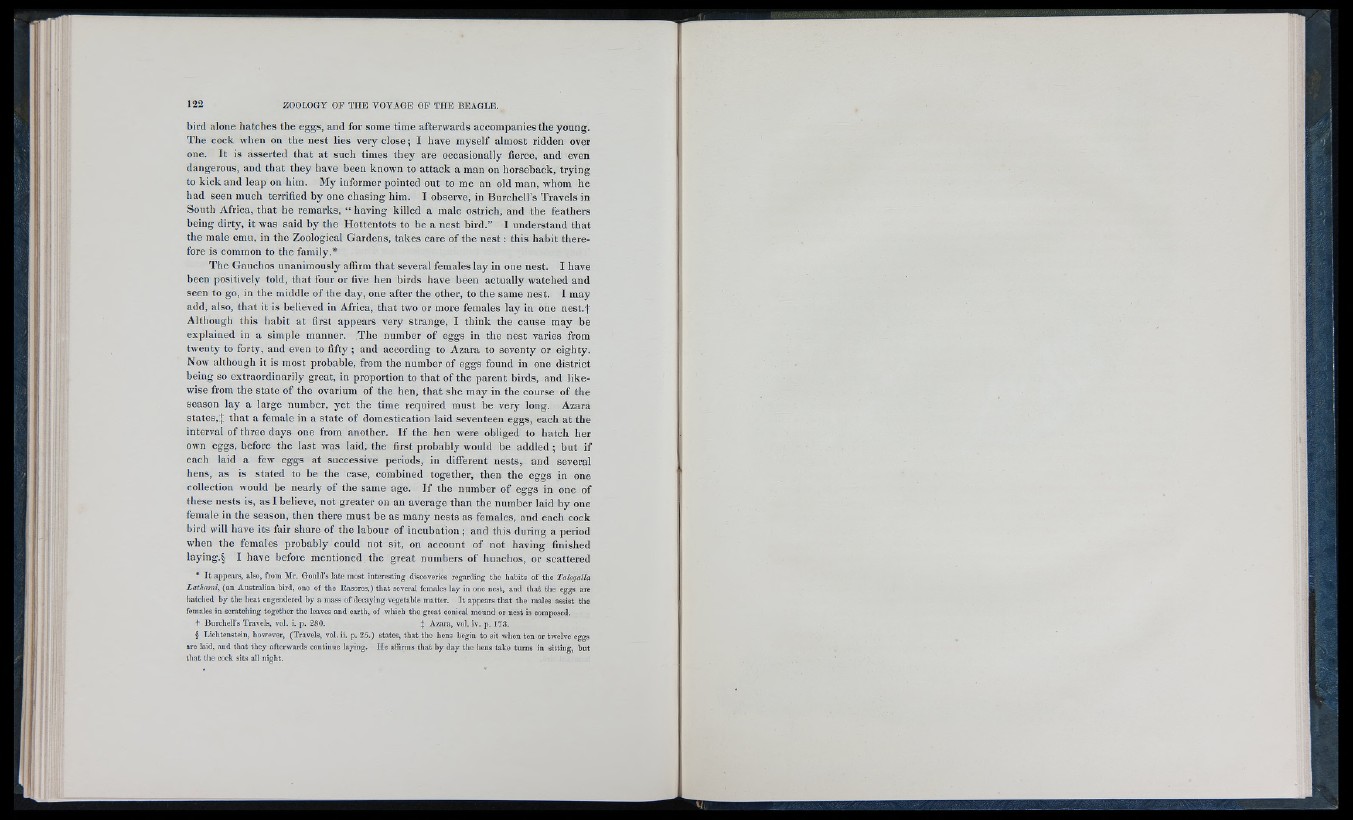
bird alone hatches the eggs, and for some time afterwards accompanies the young.
Tlie cock when on the nest lies very close ; I have myself almost ridden over
one. It is asserted that at such times they are occasionally fierce, and even
dangerous, and that they have been known to attack a man on horseback, trying
to kick and leap on him. My informer pointed out to me an old man, whom he
had seen much terrified by one chasing him. I observe, in Burchell’s Travels in
South Africa, that he remarks, “ having killed a male ostrich, and the feathers
being dirty, it was said by the Hottentots to be a nest bird.” I understand that
the male emu, in the Zoological Gardens, takes care of the nest : this habit therefore
is common to the family.*
The Gauchos unanimously affirm that several females lay in one nest. I have
been positively told, that four or five hen birds have been actually watched and
seen to go, in the middle of the day, one after the other, to the same nest. I may
add, also, that it is believed in Africa, that two or more females lay in one nest.f
Although this habit at first appears very strange, I think the cause may be
explained in a simple manner. The number of eggs in the nest varies from
twenty to forty, and even to fifty ; and according to Azara to seventy or eighty.
Now although it is most probable, from the number of eggs found in one district
being so extraordinarily great, in proportion to that of the parent birds, and likewise
from the state of the ovarium of the hen, that she may in the course of the
season lay a large number, yet the time required must be very long. Azara
states,^; that a female in a state of domestication laid seventeen eggs, each at tbe
interval of three days one from another. If the hen were obliged to hatch her
own eggs, before the last was laid, the first probably would be addled ; but if
each laid a few eggs at successive periods, in different nests, and several
hens, as is stated to be the case, combined together, then the eggs in one
collection would be nearly of the same age. If the number of eggs in one of
these nests is, as I believe, not greater on an average than the number laid by one
female in the season, tlien there must be as many nests as females, and each cock
bird will have its fair share of the labour of incubation ; and this during a period
when the females probably could not sit, on account of not having finished
laying.§ I have before mentioned the great numbers of huachos, or scattered
• Iii appears, also, from Mr. Gould’s late most interesting discoveries regarding the habits of the Talegalla
Lathami, (an Australian bird, one of the Rasores,) that several females lay in one nest, and that the eggs are
hatciied by the heat engendered by a mass of decaying vegetable matter. I t appears that the males assist the
females in scratching togetlier the leaves and earth, of which the great conical mound or nest is composed.
+ Burchell’s Travels, vol. i. p. 280. % -Azara, vol. iv. p. 173.
§ Lichtenstein, however, (Travels, vol. ii. p. 25.) states, that the hens begin to sit when ten or twelve eggs
are laid, and that they afterwards continue laying. He affirms that by day tiie hens take turns in sitting, but
that the cock sits all night.